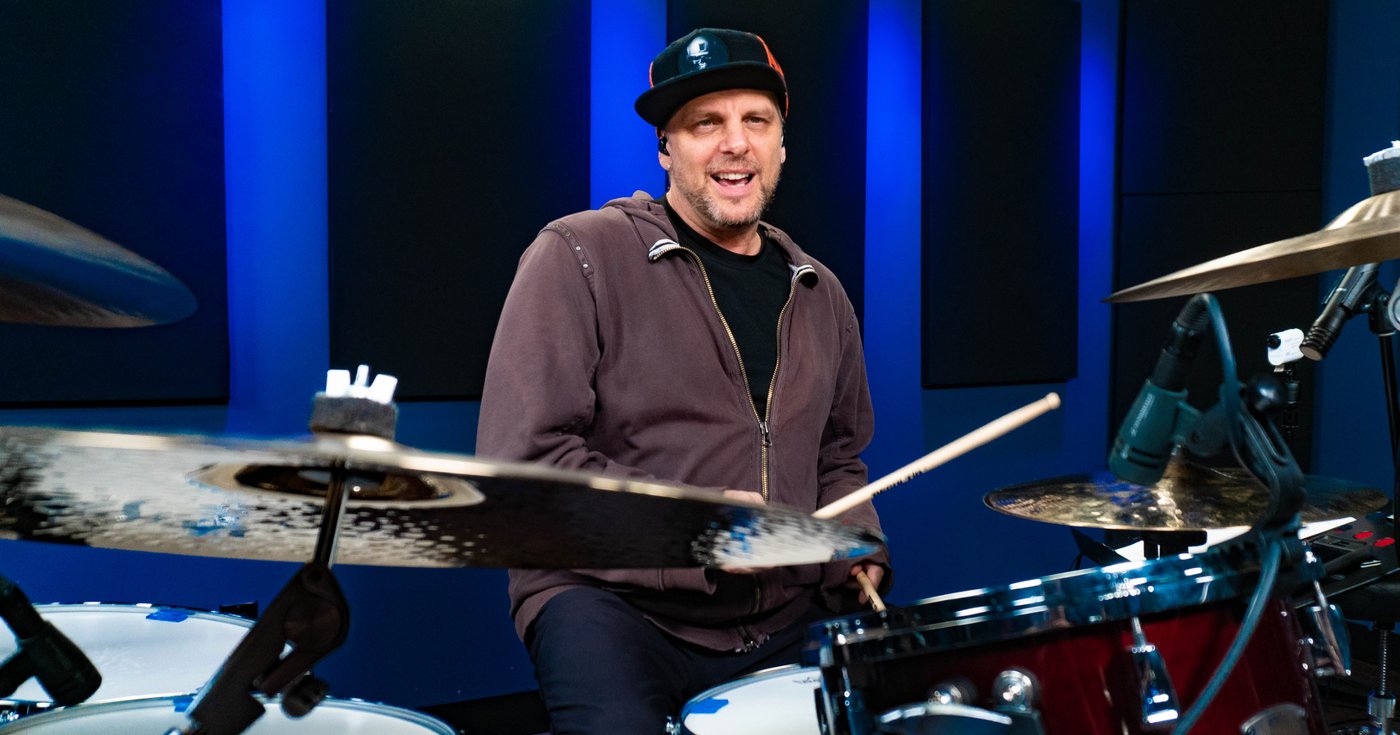
Do you know how to play one beat on the drums? Well, you actually know how to play 30 beats.
Do you know how to play 30 beats? You can turn that into 900 beats.
We aren’t exaggerating. And Randy Cooke – who’s drummed for Smashmouth, Kelly Clarkson, Five For Fighting, Eurythmics and more – will explain it all in this video course.
‘The rock beat formula’ is all about how to build around rock beats and adapt them in a ton of different ways. You’ll learn to be a more creative drummer, expand your rock drumming vocabulary, and come up with more ideas more quickly when you’re writing drum parts.
Before you get into it, you should know that this is the first time we’ve shared a full Drumeo course on The Beat or on YouTube. When we bring artists to Drumeo, we don’t just film one live lesson or a couple of quick tips (the free content we share here and on YouTube is only 1/10th of the content we film). We save the rest for Drumeo members.
What makes a course different from a single video lesson? Instead of having one lesson that combines all of the information into a summary – which can be overwhelming if you’re used to having a private teacher or aren’t sure where to start – you get multiple videos on one topic that are meant to be watched and practiced in sequence in order to build on one concept or skill set. It’s a good way to check your progress as you take steps to reach the final results.
Enjoy!
A way to take simple kick snare patterns and transform them so each time you add a layer or level or tone we make them sound different and come alive using the same groove – turning one beat into 30 beats. help you think outside the box.
Counting is another form of coordination and counting out loud helps you know if you’re doing things right – it’s something you need to do!
You can make a beat sound different just by changing the pattern you do with your lead hand (typically your right, if you’re right-handed). You can match your left hand on the snare and play flams on 2 and 4 to fatten up the sound. You can play quarter notes or 8th notes on the hi-hat, or play quarter note upbeats (where you play on the ‘and’). You can even leave your lead hand out entirely.
Try changing the ‘voice’, or sound – where does your lead hand go? It doesn’t need to play the hi-hat; it can go on the bell of the ride, on the floor tom or on the rim of a drum. You could use a crash cymbal as a ride, or your ride as a crash. You’re still playing the same thing, but it’ll sound different.
Also known as grace notes, filling in the ‘gaps’ on the snare means changing a potentially simple beat into something with a little more dynamics. Ghost notes should have next to no stick height and should be very, very quiet. A beat played with a couple of ghost notes gives you a freight train-like effect.
Take the same beats you’re already playing, but swing them! All the kicks and snare hits no longer fall on a 16th note grid, but over a triplet grid. If you change your metronome to triplets as well, there’s no guessing as to if you’re playing it properly (and it’ll help you get your swing feel rock solid). Maybe you don’t swing the whole groove – just the last 16th note. You can swing with the bass drum or swing with the grace notes. It’s your call!
Now you know how to start with the skeleton of a beat, change your lead hand pattern and voicing, add grace notes and try swinging the pattern. You can use these tips to manipulate the beats you might already know, and see how these changes alter how the song sounds and feels. Adding simple variations can make a huge difference, and will challenge you to expand your vocabulary and work on your dynamics. Experiment with different patterns and get motivated to challenge yourself. What else can you do to change how your beats sound and feel? Maybe you add accents. Maybe you add extra bass drum notes. There are no limits to what you can do when you start to think about grooves a bit differently.
If you liked this course, you’ll also like this other lesson from Randy Cooke, ‘How To Become A Rock Drummer’!
About Randy:
Randy Cooke is an established Canadian drummer, percussionist, and session/touring musician. He was a member of Smash Mouth from 2010 to 2013. He’s recorded and toured with artists such as Kelly Clarkson, Hilary Duff, Ian Gillan (of Deep Purple), Mick Jagger, Ashley Tisdale, Mandy Moore, Five for Fighting, Natasha Bedingfield, and many others. He’s also appeared on many TV shows such as Jay Leno, David Letterman, Regis & Kelly, Larry King, The View, Martha Stewart, A&E Private Sessions, and CBS Early Show.
Randy Plays:
Yamaha Drums
Zildjian Cymbals
Remo Drumheads
Regal Tip Sticks
Randy Cooke is an established Canadian drummer, percussionist, and session/touring musician. He was a member of Smash Mouth from 2010 to 2013. He’s recorded and toured with artists such as Kelly Clarkson, Hilary Duff, Ian Gillan (of Deep Purple), Mick Jagger, Ashley Tisdale, Mandy Moore, Five for Fighting, Natasha Bedingfield, and many others. He’s also appeared on TV shows like Jay Leno, David Letterman, Regis & Kelly, Larry King, The View, Martha Stewart, A&E Private Sessions, and CBS Early Show.


By signing up you’ll also receive our ongoing free lessons and special offers. Don’t worry, we value your privacy and you can unsubscribe at any time.
We use cookies for traffic data and advertising. Cookie Policy »